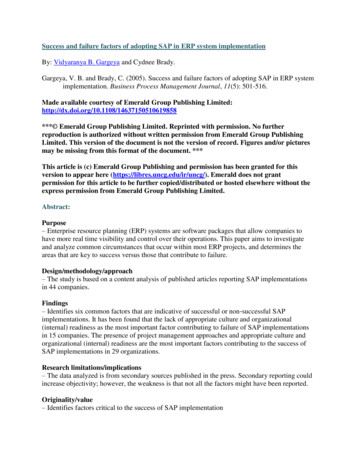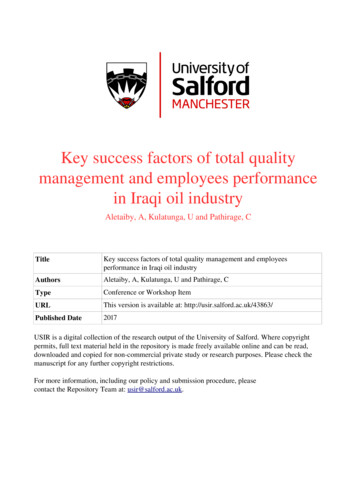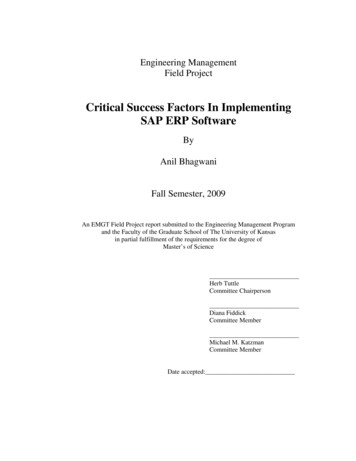
Transcription
Success and failure factors of adopting SAP in ERP system implementationBy: Vidyaranya B. Gargeya and Cydnee Brady.Gargeya, V. B. and Brady, C. (2005). Success and failure factors of adopting SAP in ERP systemimplementation. Business Process Management Journal, 11(5): 501-516.Made available courtesy of Emerald Group Publishing 8*** Emerald Group Publishing Limited. Reprinted with permission. No furtherreproduction is authorized without written permission from Emerald Group PublishingLimited. This version of the document is not the version of record. Figures and/or picturesmay be missing from this format of the document. ***This article is (c) Emerald Group Publishing and permission has been granted for thisversion to appear here (https://libres.uncg.edu/ir/uncg/). Emerald does not grantpermission for this article to be further copied/distributed or hosted elsewhere without theexpress permission from Emerald Group Publishing Limited.Abstract:Purpose– Enterprise resource planning (ERP) systems are software packages that allow companies tohave more real time visibility and control over their operations. This paper aims to investigateand analyze common circumstances that occur within most ERP projects, and determines theareas that are key to success versus those that contribute to failure.Design/methodology/approach– The study is based on a content analysis of published articles reporting SAP implementationsin 44 companies.Findings– Identifies six common factors that are indicative of successful or non‐successful SAPimplementations. It has been found that the lack of appropriate culture and organizational(internal) readiness as the most important factor contributing to failure of SAP implementationsin 15 companies. The presence of project management approaches and appropriate culture andorganizational (internal) readiness are the most important factors contributing to the success ofSAP implementations in 29 organizations.Research limitations/implications– The data analyzed is from secondary sources published in the press. Secondary reporting couldincrease objectivity; however, the weakness is that not all the factors might have been reported.Originality/value– Identifies factors critical to the success of SAP implementation
Keywords: Manufacturing resource planning Critical success factorsArticle:IntroductionEnterprise‐wide resource planning (ERP) system software packages are highly integrated,complex systems for businesses, and thousands of businesses are running them successfullyworldwide (Koch, 1996). Even companies such as Hershey, JoAnn stores, Whirlpool andSamsonite that have suffered through classic disasters, acknowledge the software packages areable to handle the job. The systems are capable of functioning as advertised; however, companiesrun into costly and sometimes fatal difficulties with the implementation and subsequentmaintenance of these packages.According to The Gartner Group, 70 percent of all ERP projects fail to be fully implemented,even after three years (Gillooly, 1998). Typically, there is no single culprit responsible for a“failed implementation”, and no individual reason to be credited for a successful one. Even thedefinitions of failure and success are gray areas, lending to interpretation. There are generallytwo levels of failure: complete failures and partial failures. In a complete failure, the projecteither was scuttled before implementation or failed so miserably that the company sufferedsignificant long‐term financial damage. Those implementations considered partial failures oftenresulted in tenuous adjustment processes for the company; creating some form of disruption indaily operations. In the same vein, an ERP success can be a complete success – one in whicheverything goes off without a hitch, or one in which there are few alignment problems, resultingin minor inconvenience or downtime. Frequently, these situational circumstances that have to beironed out in the weeks and months after the “go‐live” date are not severe enough to disrupt thedaily operations.There are dozens of vendors of ERP systems. However, the top five ERP system vendors areSAP, Peoplesoft, Oracle, J.D. Edwards, and Baan. SAP has been recognized as the leader withmore than 50 percent of the market (Burns, 1999; Mabert et al., 2000;Stratman and Roth,2002; Vaughan, 1996). Hence, the current study has focused on SAP implementations as aleading example of ERP system implementation.One of SAP's major strengths includes the extensive capability of the software's functionality.Perhaps two of its shortcomings are the complexity of the system and the resultingimplementation. It is widely used in industries such as chemicals and pharmaceuticals (processindustries), and also in oil and gas industries. By making a huge and ongoing investment inresearch and development, SAP continues to strive for increased dominance of the ERP market.Accordingly, developments are underway to gain strength in many other sectors of the economy.There are over 20,000 customers running the SAP software systems today; this equates to 20,000“successful” implementations. Some of these were originally failures, requiring iterative attemptsat making the software work as designed.
In order to determine factors that will indicate early on whether a project will be successful, ordoomed to potential failure, 44 companies that implemented SAP were reviewed. Thesecompanies vary in size, industry and scope of implementation. The research methodologyemployed for the analyses was that of content analysis, which examines the content withinpublished articles, and processes the information contained within them through qualitativeprocesses. The companies analyzed implemented SAP between 1995 and 2000.The next section provides a review of the literature on the implementation of ERP systems. Thethird section of paper describes the research methodology adopted for this paper. The fourthsection elaborates on the findings and describes the factors that play a role in success or failureof SAP implementation. The last section draws some conclusions.Enterprise resource planning systemsAn effective business strategy centers on an aggressive, efficient use of information technology;for this reason the ERP systems have emerged as the core of successful informationmanagement, and the enterprise backbone of the organization (Nash, 2000a, b). A successfulERP system will streamline processes within a company and improve its overall effectiveness,while providing a means to externally enhance competitive performance, increase responsivenessto customers, and support strategic initiatives (Sandoe et al., 2001). The benefits of ERPsystems, once the pains of implementation are over, appeal to companies.There are many factors to be considered in making the decision of whether to implement an SAPsystem or not. The technical aspect is not the only factor that needs to be considered;unfortunately many companies have not seen this until it was too late. The financial commitmentis substantial; therefore, chief executive officers and senior executive teams must be deeplyinvolved. Simply put, ERP is not intended for every business. When considering the decision toinvest in an ERP system, a business case must be developed to provide an understanding of ERP,and to formally assess the benefits that the company – as an individual entity apart from itscompetitors – can expect to achieve. The analysis must consider not only the obviouscost/benefit analysis, but also the non‐financial factors. Non‐financial benefits includeinformation visibility and flexibility (Sandoe et al., 2001). A more complete listing of tangibleand intangible benefits is provided in Table I. ERP implementation costs are incurred in threeareas: software, hardware, and personnel. The personnel (or the human resources) cost is by farthe largest and most expensive, but at the same time has been the area given the least amount ofconsideration. The software and hardware costs are often easily quantifiable; however, the“human” cost is not (Davenport, 2000).There have been a few papers recently published on the factors contributing to ERPimplementation. Dong (2001) proposed a conceptual model exploring the impact of topmanagement on enterprise systems (ES) implementation. Aladwani (2001) described anintegrated, process‐oriented approach for facing the complex social problem of workers'resistance to ERP systems. Huang and Palvia (2001) proposed ten factors (at thenational/environmental and organizational level) concerning ERP implementation by making acomparison of advanced and developing countries. The national/environmental factors identifiedby them are economy and economic growth, infrastructure, regional environment, government
regulations, and manufacturing strengths. They also noted that information technology maturity,computer culture, business size, business process re‐engineering experience, and managementcommitment are the organizational level factors. Huang and Palvia (2001) did not categorize thefactors into those that contribute to success and those that contribute to failure.Nah et al. (2001), based on a study of earlier papers (most of which were normative/prescriptivein nature), identified 11 factors that were critical to ERP implementation success. The 11 factorsnoted by them are1. ERP teamwork and composition;2. change management program and culture;3. top management support;4. business plan and vision;5. business process re‐engineering and minimum customization;6. effective communication;7. project management;8. software development, testing, and trouble shooting;9. monitoring and evaluation of performance;10. project champion; and11. appropriate business and information technology legacy systems.None of the above papers were based on any primary empirical data (in the form of survey orcase research) or secondary data (content analysis of reported cases or surveystudies). Themistocleous et al. (2001), based on a survey of 50 respondents, underscored theneed for integration of existing systems with ERP applications in ERP implementation. Stratmanand Roth (2002)through a questionnaire survey of 79 North American manufacturing users ofERP systems identified eight generic constructs (strategic information technology planning,executive commitment, project management, information technology skills, business processskills, ERP training, learning, and change readiness) that are hypothesized to be associated withsuccessful ERP adoption. However, the works of Nah et al. (2001), Themistocleous etal. (2001) and Stratman and Roth (2002) do not focus on factors of failure.Umble and Umble (2001) expressed their views on 14 success factors (definition of businessgoals, establishment an executive management planning committee, thinking of implementationas research and development, use of cross‐functional teams, stocking implementation teams withthe best and smartest workers, alignment of everyone's interest by giving mid‐level management
hands‐on responsibility, constant communication with teams and end users, excellent projectmanagement, choice of partners, extensive education and training, management with data,measurement of the right things, establishment of aggressive achievable schedules, and no fearfor change) and nine failure factors (top management failure, poor project management, lack ofeducation and training, people do not want new system to succeed, unrealistic expectations aboutimplementation, inaccurate data, attempt to automate existing redundant or non‐value‐addedprocesses, mismatch between the business and ERP system selected, and technical difficultiescan lead to implementation) in ERP implementation. It appears that the work of Umble andUmble (2001), though normative/prescriptive for failure and success of ERP implementations, isnot based on a systematic analysis of ERP implementations in different organizations.In summary, the review of the literature shows that there is not much of research done onidentifying the factors of SAP implementation success and failure based on the content analysisof published articles and books. That is the main thrust of the current work.Research methodologyThe primary purpose of this research is to find out the factors that contribute to success andfailure in adopting SAP. Content analysis has been be used to infer from published articles thefactors that lead to success or failure for an ERP project, specifically SAP implementations.Content analysis is “fundamentally empirical in its orientation, exploratory, and predictive in itsintent” (Krippendorf, 1980). This research technique is often used to determine the bias betweentwo sides of an issue (for instance, labor unions versus manufacturers), to determinequantitatively whether readers can and are being influenced by the manner in which an article iswritten, or even where it is placed in a publication. The facts of a successful or unsuccessfulimplementation are fairly straightforward – the project succeeded or it did not as measured byfinancial standards, or by operational standards. Content analysis was used on this level as a toolto analyze the material and make recommendations that will provide knowledge, new insights,and a practical guide to future actions (Krippendorf, 1980). This content analysis is not to swaythe reader into forming an opinion of the outcome, only to indicate specific factors that relate tothe outcome.The data generating and data reduction methodology involved analyzing textbooks, journals andmagazine articles for information related to companies that have implemented SAP software.Companies that implemented SAP between 1995 and 2000 period were analyzed. Articles werechosen through a library database, using search keywords of SAP, ERP, SAP success, SAPfailure, and implementation. Companies were removed if the supporting articles only detailedwhat happene
Success and failure factors of adopting SAP in ERP system implementation By: Vidyaranya B. Gargeya and Cydnee Brady. Gargeya, V. B. and Brady, C. (2005). Success and failure factors of adopting SAP in ERP system implementation. Business Process Management Journal, 11(5): 501-516. Made available courtesy of Emerald Group Publishing Limited:File Size: 599KBPage Count: 17











